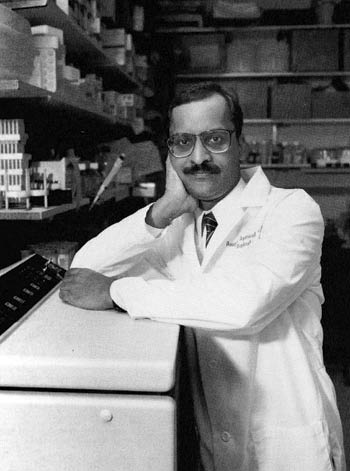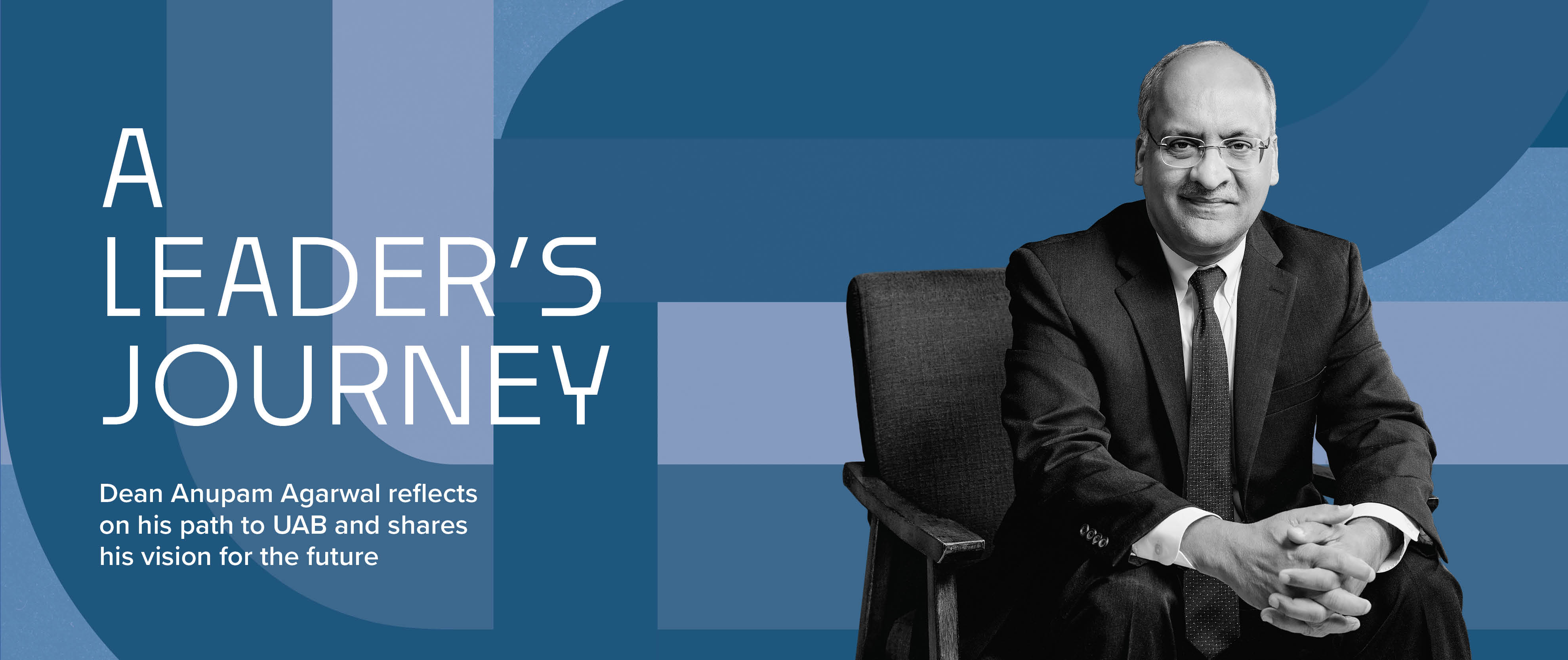On February 3, 2023, a new era in the history of UAB began when it was announced that Anupam Agarwal, M.D., was named senior vice president for Medicine and dean of the UAB Marnix E. Heersink School of Medicine. The role is a high-water mark for Agarwal, who is the product of an eclectic life’s journey, one that was guided by a wide array of influences and interests.
His parents hailed from Uttar Pradesh in northern India. His father graduated from the King George Medical College in the city of Lucknow and moved to southern India in 1959 to teach pathology at Kasturba Medical College at Mangalore University, a medical college in the coastal town of Mangalore.
Agarwal says his parents’ greatest gift to their three sons was education. “When I was young, my parents never wasted a moment in highlighting the value of great education and pushed us hard to make use of the best possible opportunities at school.”
Early Interests
Agarwal’s early education at St. Aloysius School, a Jesuit-run Catholic school in Mangalore, brought him into contact with classmates from a broad range of backgrounds and beliefs, some of whom he still calls friends. “My town was about 15 percent Catholic— the Portuguese and Italians who came in the 1500s to the coastal regions of southern India to spread Christianity settled there—and it has amazing diversity. There were about 60 students in my class, and we had Muslims, Hindus, Catholics. To this day I have a WhatsApp group of my former classmates, who remain highly engaged and active as a closely knit group of friends.”
Many of Agarwal’s overriding interests and passions began while he was a student at St. Aloysius. He became an avid cricket player and played ping-pong and basketball (“I was short so I was a good three-point shooter,” he says). He learned to play the Indian classical violin—in part inspired by his mother’s love of music—which contributed to his lifelong appreciation for classical music. Not surprisingly, Agarwal also showed an early aptitude for science.
Because his father was a pathology professor, Agarwal was essentially raised at the medical college. “We lived in campus housing growing up and my dad was the warden for the medical students’ residence hall. So I grew up hanging around medical students, even though they were much older than me.”
Given his upbringing, it seems inevitable that Agarwal would develop an interest in medicine, but he cites a specific event as the turning point that cemented his desire to become a physician. “My dad brought a specimen of a heart in a formalin-filled jar to my fourth-grade class. He explained to my class how the heart works and pumps blood, and I remember thinking, ‘Wow, I want to practice medicine.’ That was tremendous for me.”
 Agarwal at the University of Florida, where he worked from 1995-2003.
Agarwal at the University of Florida, where he worked from 1995-2003.
Making it to Medical School
Agarwal graduated St. Aloysius at the head of his class and entered Kasturba Medical College in 1980 after completing a two-year pre-university college (equivalent to 11th and 12th grade). While completing the Indian standard of six years of medical school, including a compulsory one-year rotating internship, he considered a number of specialties but ultimately settled on nephrology after encountering one of his earliest mentors in medicine. Agarwal decided to specialize in nephrology based on conversations with Brian Pereira, a nephrology fellow. Pereira argued that, “‘You can help patients through kidney transplantation and dialysis and their life is transformed. You can work in the intensive care unit managing acid-base, fluid, and electrolyte disorders and also take care of general medicine patients,’” according to Agarwal.
Another influential mentor during Agarwal’s residency training was the late Dr. Kirpal Singh Chugh, considered the father of nephrology in India. Agarwal remembers Chugh as being very patient-focused and having high expectations for his trainees. “Dr. Chugh was an exceptional teacher and mentor. He was very academically oriented. We’d be on rounds and he’d see a patient and say, ‘This is an interesting and unusual case presentation, we need to write this up and publish it so people can learn about it. Why don't you write this case?’ Then a week later he’d ask, ‘Where is this case report? I’d like to review it by tomorrow.’”
The Path to UAB
Agarwal completed three years of residency in internal medicine and three years of fellowship training in nephrology at the Postgraduate Institute of Medical Education and Research in Chandigarh. Then he encountered a roadblock that set him on a new path. “Academically at that time you couldn’t do much in terms of research in India, and my brother, who was already in the U.S., suggested that I do additional training in the U.S.” Agarwal says.
After passing the USMLE exams, Agarwal had a phone interview with the University of Minnesota. He was offered a fellowship position and was mentored there by Karl Nath, M.D., now at the Mayo Clinic in Rochester. “Karl was a most amazing and caring mentor. He took me into his lab, and I had never done basic research before, only clinical research. But it was a great experience—in those two years I was fortunate to have published three review articles and three first author papers.”
Agarwal spent three years as a nephology fellow at Minnesota and another year at the University of Florida in Gainesville, as a postdoctoral fellow/instructor in the lab of molecular biologist Harry Nick, Ph.D., where he met his wife, Lisa Curtis, Ph.D. The two were married in 2002.
Then in 2003 he was recruited to UAB by the former Director of Nephrology David Warnock, M.D. “It was the collaborations and the impressive medical school and health system that really excited me; I could see how quickly you could enable interactive collaborations here. Bruce Freeman, Ph.D., who was the vice chair for research of anesthesiology at the time, really influenced our decision to come. We initiated a collaboration even before I had moved to UAB, work that was subsequently published in the Proceedings of the National Academy of Sciences.”
2008-2021 Division Director, Nephrology • 2009-2014 Vice Chair of Research, Department of Medicine • 2011-2012 Interim Chair, Department of Medicine • 2013 Interim Senior Vice President for Medicine and Dean
• 2014-2022 Executive Vice Dean, Heersink School of Medicine 2023 Senior Vice President for Medicine and Dean
Putting Down Roots
The following year brought another landmark moment for Agarwal. “In 2004, I went to the federal courthouse in downtown Birmingham to get my U.S. citizenship conferred. There were about 160 of us from many different countries, and the judge said, ‘I want you all to know that just like you, my great-grandfather once sat in a crowd just like this.’”
Agarwal joined the Division of Nephrology as an associate professor and director of the Nephrology Research and Training Center. He was promoted to the rank of professor of Medicine in 2005 and went on to direct the NIH-funded O’Brien Center for Acute Kidney Injury Research, one of seven such centers in the nation. Agarwal’s research into the mechanisms of acute kidney injury has been continuously funded by the NIH for over 25 years.
In 2008, Agarwal succeeded Warnock as director of the Division of Nephrology, a position he held until 2021. In 2014, he was appointed to the newly created role of executive vice dean of the Heersink School of Medicine, where he worked closely with former Senior Vice President for Medicine and Dean Selwyn Vickers, M.D., FACS, and the dean’s leadership team. Upon Vickers’ departure, Agarwal was the natural choice for interim dean, having previously served in the role when the search that resulted in Vickers’ appointment as dean was underway.
In 2020, Agarwal became president of the American Society of Nephrology (ASN), the leading organization of nephrology health care professionals with more than 20,000 members representing more than 120 countries.
“I never thought in my wildest dreams when I first came here 30 years ago that I would be president of the ASN, the director of Nephrology, and now dean. I think one takeaway and lesson I have learned throughout my life has been knowing that I had to do my very best with the opportunities that came to me. I am forever grateful for all the opportunities that have been given to me.”
Now that he has been appointed dean, Agarwal continues to see patients at the Birmingham VA Medical Center. “I usually do inpatient consult service for nephrology, mainly in the intensive care unit. I really enjoy doing that so I hope to continue interacting with residents and fellows on the clinical service.”

Agarwal says he knows he’s in rare company as a person of Indian descent to become dean of a U.S. medical school. “This is a huge honor for someone who was trained in India and in the U.S. to become a medical school dean,” he says.
In addition to his professional duties, Agarwal is a father of two, son Alex (15) and daughter Megan (14). His many interests include golf and he is an avid supporter of the Alabama Symphony Orchestra, chairing the Physicians and Faculty for the Alabama Symphony Orchestra giving society. For his service he was given a commemorative conductor’s baton, which now hangs on his office wall.
The Road Ahead
As he plans for the future of the Heersink School of Medicine, Agarwal sees opportunities to address some of the most pressing health challenges facing our state and nation through the school’s tripartite mission in medical training, patient care, and biomedical research. In the medical training realm, Agarwal says his vision is for our school to “produce exceptional physicians prepared to provide compassionate care to all, reduce health disparities, advance treatments, and make discoveries.” He says this can be accomplished by enhancing access to and success in medical school for more students; enhancing pathways for medical students to be recruited to UAB residency programs; and identifying incentives for our graduates to practice in rural and underserved areas.
Among his key medical education goals are increasing the size of our medical school classes; expanding our graduate medical education (GME) programs to address the health care workforce needs of the state, particularly in primary care specialties and mental health; expanding integrated residency programs; and increasing scholarship funding for those with financial need.
5 Questions
with Dr. Agarwal
What are you currently reading?
Dan Berkowitz (chair of the Department of Anesthesiology and Perioperative Medicine) gave me an amazing book by Dacher Keltner that I’m reading right now called ‘Awe: The New Science of Everyday Wonder and How It Can Transform Your Life.’"
What is your favorite movie?
"I love action movies like the ‘Bourne Identity’ series, but a movie I’ve watched and rewatched is ‘Forrest Gump.’ I saw it in Minnesota on opening day in 1994 with another nephrology fellow and I said, ‘That movie is going to win all the Oscars this year.’"
What is your favorite restaurant?
“I love Blueprint on 3rd. They make a great burger with all these toppings and shoestring fries.”
Favorite golf course?
Pebble Beach in California
Do you have any pets?
“We have a six-year-old Goldendoodle named Lulu
Agarwal’s key priorities in clinical care include strengthening alignment and collaboration with the UAB Health System and its affiliate hospitals, as well as increasing capacity and improving access to care, especially in overcrowded units such as the Emergency Department, intensive care units, and operating rooms. “A recently completed clinical strategic planning effort will enable us to identify growth opportunities,” Agarwal says.
Strengthening rural hospitals by enhancing their capacities and expanding telehealth and hospital-at-home programs is also a key part of Agarwal’s vision. “A lot of what we’re doing with telemedicine is aimed at helping rural hospitals stay open,” says Agarwal. “Nationally, rural hospitals are shutting down at an alarming rate. Our telemedicine programs, through the leadership of Dr. Eric Wallace, have made a big difference in keeping the doors open at several rural hospitals here in Alabama.”
Agarwal also says the impact of digital health and artificial intelligence (AI) tools on health care is only beginning to be explored and will be transformational. “With new initiatives in artificial intelligence and digital health being led by our Marnix Heersink Institute for Biomedical Innovation, there are even more opportunities for innovation in health care delivery.”
In the research arena, Agarwal says the school’s four Research Focus Areas that were identified in 2022—Disruptive Technology Empowering Precision Health (D-TECH); Infection, Inflammation, Immunity, and Immunotherapy (I-4ward); Brain Health and Disease Across the Lifespan; and Health Equity—will serve as a roadmap to guide our future research recruitment and investment efforts.
Increasing NIH research funding and the school’s NIH funding ranking is an important part of Agarwal’s research vision. In the long-term, he says he wants the Heersink School of Medicine to achieve a top 20 ranking in NIH funding by 2030. He also seeks to expand and diversify the school's research portfolio with funding from agencies such as the Department of Defense, American Heart Association, American Cancer Society, and National Science Foundation. In addition, a UAB-wide initiative to establish a roadmap to reach $1 billion in total research expenditures announced this August seeks to increase funding from similar sources.
“I want us to continue to invest in our people, both by supporting currently funded projects and programs and by investing in recruitment. We want to recruit 100 new faculty investigators by 2030, and our recent past shows it can be done—we doubled our NIH funding and added 100 new investigators in the last eight-to-nine years.”
Agarwal says several construction projects that are currently underway will also aid recruitment. A new Biomedical Research and Psychology Building will house several research intensive departments from the Heersink School of Medicine, while renovations to the McCallum Basic Health Sciences Building, a longtime research hub on the school’s campus, will be completed in 2024.
Announced in December 2020, the Altec Styslinger Genomic Medicine and Data Sciences Building is part of the Heersink School of Medicine’s long-range plan to enhance research in genomic medicine and computational biology. The new building will encompass 145,000 square feet of new computational research, research support, office, administrative, and scientific collaboration and meeting spaces. Among Agarwal’s key priorities in research are addressing processes to reduce time to activation for clinical trials; investment in technology and instrumentation; enhancing career advancement pathways for trainees; and building upon collaboration with key partners, like Southern Research, a nonprofit scientific research organization, and the Birmingham VA Health Care System.
Agarwal says the Heersink School of Medicine also has a special responsibility to our state and region because of the school’s unique strengths and our state’s unique needs. “The economic impact we have, as a school and as a health system, puts us in a strong position to give back to our state and our region. That’s true at all levels—people depend on us for health care, for innovative treatments, and for training the next generation of physicians.”
Ultimately, Agarwal’s vision boils down to investing in people. “We have highly talented and committed faculty and staff as well as medical students, graduate students, residents, postdoctoral and clinical fellows, our nursing staff, our APPs (advanced practice providers)—our people at every level are high quality. They have a shared vision and goals that are aligned with the collaborative spirit of our institution, and that is our greatest strength.”
-By Jane Longshore
